South Africa, known as "Africa's engine," generates 20% of Sub-Saharan Africa's Gross Domestic Product (GDP). Securing outstanding human resources that will support industry is essential for not only South Africa's development but also that of the Southern African region and even of Africa as a whole. Japan supports the introduction of training programs that boost the practical skills of the young people who support Africa's future.
Photography: Akihito Yoshida
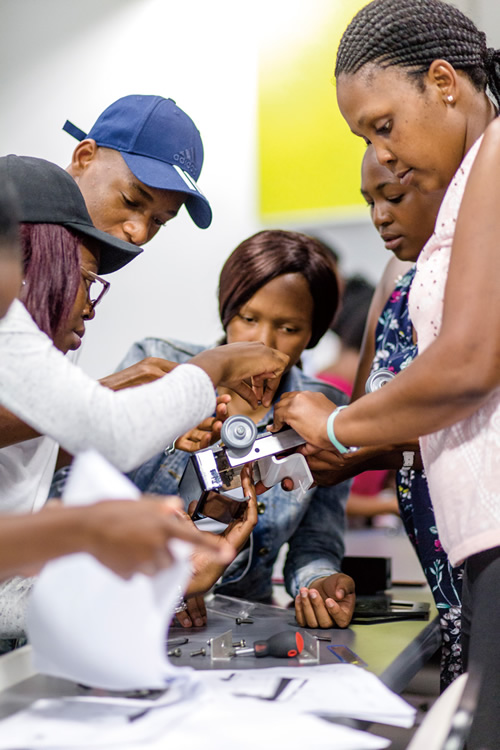
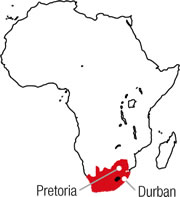
Students assembling a miniature truck in order to learn the necessary skills for discovering problems in the workplace. The truck is based on one used by Nissan for training at its plant in Pretoria.
From Division to Harmony:
A Country that Overcomes Contradictions to Grow
"Rainbow Nation." This alternative name for South Africa symbolizes a society where many ethnicities and races coexist. The journey to get to this state of society, however, was anything but peaceful. Beginning in the 17th century, Dutch and British citizens, one after another, swarmed and colonized this fertile land, which was already home to black Africans. After South Africa gained independence following World War II, apartheid-racial segregation-came into effect, placing restrictions on the rights of citizens according to race. It was a major turning point when all discriminatory laws were abolished in 1991 following the conclusion of the Cold War. In 1994, the late Nelson Mandela, an anti-apartheid activist, was elected as president. Mandela was imprisoned as political criminal for 27 years, and this year marks 27 years since the abolition of racial discriminatory laws. South Africa's journey as "the Rainbow Nation" for coexistence of diversified groups has just started.
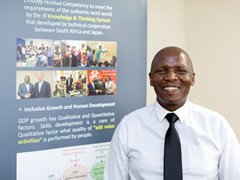
Mahlubi Mabizela, Chief Director of higher education policy at DHET. Mabizela says he wants to deepen ties with Japan and increase personnel exchange.
Instead of displacing white people from South African society, the Mandela administration chose a path where all races would coexist. In this way, the country took over the industrial foundation built by whites, including infrastructure and scientific technology, and made it an asset of all citizens. The current development of the country still largely relies on the utilization of bequeathed properties under white control. At the same time, a negative legacy still exists; social disparities, in particular those between races, are manifest.
Under apartheid, many blacks and other people of color were not given sufficient opportunities for education, resulting in great discrepancies in the level of education between racial groups up to now. In particular, South Africa has long been at the bottom in world rankings of math and science education (as researched by the World Economic Forum). To help South Africa address this, Japan is providing support to restructure the math and science curricula in South African basic education.
Another challenge is the lack of problem-solving capabilities required in the workplace. Mamoru Iida, JICA's advisor to the Department of Higher Education and Training (DHET), explains, "The old style of education that places emphasis on cramming / memorization is still mainstream in this country, so many young people are facing difficulties of acquiring the attitude of seeking out problems on their own and working to solve them logically."
Similarly, Mahlubi Mabizela, Chief Director of higher education policy at DHET, mentions inequality, poverty, and unemployment as three challenges the country is facing. "Our country needs to develop human resources who have practical skills and are capable of independent thinking. If such individuals are allowed to thrive in the workplace and start their own businesses, it will lead to development in our country and help bring us closer to solving these three problems in our society."
The Employability Improvement Project (EIP) has been launched at universities of technology nationwide and is being promoted based on the desire to improve practical skills that can be used in society by young people in South Africa and provide them with educational opportunities that will instill independent thinking.
Changing Perspectives and Ways of Thinking
by Developing Human Resources to Mobilize Society
In urban areas around South Africa where industry flourishes, there are a total of six universities of technology that train human resources who will support all of the country's industries, ranging from education and tourism to high technology. The aim of EIP is for these six universities of technology, as well as the University of Johannesburg, to send out new working members of society with problem-solving skills by providing short-term training programs to students.
We visited Tshwane University of Technology (TUT), which was the first institute in South Africa to implement EIP. "Tshwane" is the name of the metropolitan area where Pretoria, the administrative capital of South Africa, is located. With more than 64,200 students, TUT is the largest University of Technology in South Africa. It has introduced EIP primarily in its departments of science and engineering, and the expected results are being noticed.

Prof. Stanley Mukhola, Deputy Vice-Chancellor, Tshwane University of Technology (left) and Esau Motaung, Director of Cooperative Education. They have actively taken the lead in introducing EIP.
Deputy Vice-Chancellor Prof. Stanley Mukhola says that students who participated in EIP have shown a clear change in attitude. "The number of students, who have developed a greater sense of responsibility by learning teamwork through the training is increasing. I hope to make EIP a requirement for all students so that we can develop not only the human resources required by the industrial world of today, but also the human resources who will play a role in our country's industries 10 years from now."
Esau Motaung, Director of Cooperative Education, says that EIP will change the way that students look at things and give them the ability to make logical connections and organize their thoughts. "The change in students' attitudes, and acquiring the ability to discover and solve problems, are a big change for them. In the future, I hope to work with the companies that take them in, receive feedback, and continue to strengthen this initiative."
Universities of technology in South Africa have adopted a framework called the Work Integrated Learning (WIL) program. The purpose is to promote a smooth transition to careers following graduation by having students experience internships at actual workplaces before and after taking university classes. EIP is positioned as an introductory stage of the WIL program, and funding assistance for activities is provided by the National Skills Fund (NSF). The whole country is promoting the movement to improve the working skills of new working members of society.

Many young people attend Tshwane University of Technology. Universities of technology in South Africa originated from technical schools, and one of their primary missions is to develop human resources that will play active roles in the industrial world.
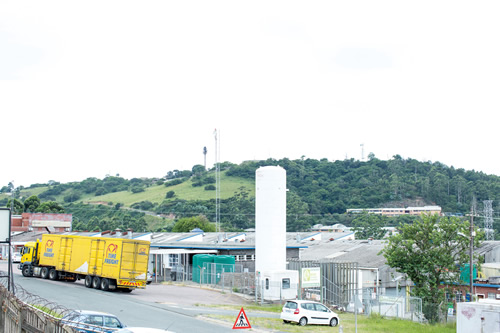
An industrial area in the suburbs of Durban where Duys is located. Various kinds of industrial plants are crowded together in this hilly area
Awareness Leading to Practical Skills through
Hands-on Experience
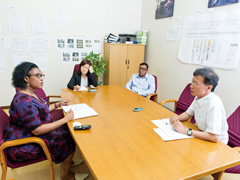
Bongiwe Sithole (left) has high regard for the practical ability of students who participated in EIP. Her company makes parts for domestic locomotives, Toyota, Nissan, and others.
Located on South Africa's Indian Ocean coast about a one-hour plane ride from Pretoria, Durban is South Africa's second largest city. It is an important trade port and is also a major industrial center with many production plants. Durban University of Technology has 27,000 students and multiple campuses located not only in Durban but also in Pietermaritzburg, the capital of the province of KwaZulu-Natal.
When we visited lecturer Jay Paramanund who works as the university's EIP Program Coordinator, there was an EIP program going on for first year students in the Co-operative Education Department. After explaining basic concepts in business like the PDCA cycle, Paramanund lined up a large number of parts in front of the students. He divided the students into three groups and instructed them to assign a leader and an inventory manager for their group. "Now I would like you to make a vehicle," he said. The parts he had lined up in the classroom were for a miniature truck. Each group was supposed to be a "plant" that would manufacture a miniature vehicle.
The ways the groups worked on the challenge were different. For example, one group had all members engage in discussion, while another group broke down into smaller teams early on. Parts management was also handled differently, such as one group breaking down into teams, and another one working as a single group to gather parts and build up stock. Watching the students having fun working with the assembly manual in one hand will make you forget that it's a university class. Iida, JICA Expert, let us in on a secret while watching the students work, "There's actually a trap in the manual. There are parts where the work will be difficult if you follow the instructions during assembly."
When the group work was finished, Paramanund asked the students to bring him the trucks they made. This is where quality control came in. The trucks that were made by each group had various defects, such as bent tires and crooked vehicle bodies. There were also several things that would be a problem in an actual workplace, such as extra parts prepared but were not actually used. The point of EIP is to equip students to notice these things and let them think about how to address problems.
Rie Shinozaki is a JICA Expert from World Business Associates Co., Ltd, who works on EIP with Iida and goes around universities to provide program instructions. She says, "While doing the assembly over two or three times, the students gradually begin to come up with their own ideas and start to make more finished products with higher efficiency. This includes cleaning up the desk that serves as their work area and creating an assembly line system for the parts." The experience of thinking for themselves rather than just doing things according to the instructions, like when the students implemented countermeasures after finding the trap in the manual, changes the behavior of young people in the places where they work.
We drove from Pietermaritzburg toward Durban on the highway. The highway is well-constructed, with two lanes going in either direction, and three in some places. The rows of small- and medium-sized plants in the industrial park are reminiscent of the scenery in industrial areas of Japan. In this region, we visited a company that hires graduates of Durban University of Technology.
Bongiwe Sithole, Human Resource Manager of the Duys Engineering Group, has high regard for graduates who participated in EIP. "They have a high capacity to understand the purpose of each task in work and are conscious of making a contribution to the workplace. This makes them stand out from other new working members of society. It will be good for society as a whole if young blacks and other people of color (editor's note: mixed-race individuals, those of Southeast Asian descent, etc.) get employed and excel at jobs that the older generation could never have imagined, by receiving this education. They are rays of hope shining in South African society." Sithole, who was raised in a household that valued education, did not hide her expectations for new graduates and young people undergoing practical education.
Opportunities to Learn Working Skills,
Spreading over Neighboring Countries
We headed back to Durban University of Technology and talked to professors who are implementing EIP for students under Paramanund's instruction at the Durban City Campus. Lecturer Nee Sobantu Ntola of the Department of Chemistry, Faculty of Applied Sciences said, "When we implemented EIP at our department, one of the students questioned the EIP by asking, ‘Is this really something that we should be doing in class in the Department of Chemistry?' But when the first day of class was finished, that same student told me, ‘I look forward to tomorrow.' This program is a good stimulation for all students regardless of their field." Shanaz Ghuman of the Department of Community Health Studies emphasizes, "Traditionally, important things for a working member of society like proper execution of work and time management were not taught at school. When I was little, I learned such things while helping out with my parents' business, but today opportunities like that are rare. For many young people, EIP is a precious opportunity to learn practical skills."
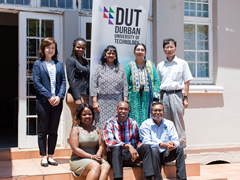
With the team involved in promoting EIP at Durban University of Technology. Rie Shinozaki (back row, leftmost), Mamoru Iida (back row, rightmost), and Jay Paramanund (front row, right).
Thami Dlamini, who participated in EIP as part of the WIL program and also did an internship, reflects, "Before undergoing the training, I couldn't even imagine what ‘adaptability to the workplace' meant. Not only are the skills I learned participating in EIP essential in the workplace, they're also applicable and important in everyday life."
Thus far we've looked at only the positive side, but the employment situation in South Africa is dire. At 26.7%, the unemployment rate is one of the highest in the world, and among young people, the rate is nearly 40% (according to the National Statistical Office, based on the first quarter survey of 2018). The unemployment rate is particularly high among blacks and other people of color who have been less fortunate in obtaining an education. On the other hand, if the educational situation for this group is improved and they are able to become outstanding human resources, they could be a spark for the South African economy.
Iida emphasizes, "Economic development serves as the driving force for solving social problems and also improves the living standard of each individual. With the improved living standard, it becomes easier for children to receive education and for outstanding human resources to be sent out into society, which leads to further economic development. Fostering outstanding industrial human resources is a major key to getting a cycle of growth going and achieving the national economic plan for 2030."
DHET Chief Director Mabizela explains, "Eight percent of students studying at South African universities have come from neighboring Southern African countries to study. Moreover, the same cooperation has expanded to the nearby Namibia University of Science and Technology through EIP. To help develop the Southern African region, it is absolutely essential that we improve the quality of education in this country and develop outstanding human resources." Iida also narrates, "There are parts of South Africa that are developing, but they face the same problem of poverty as other African countries, particularly in rural areas. Attempts to solve social problems in South Africa will provide hints for solving not only its problems, but that of other countries as well."
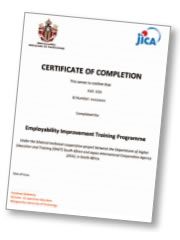
A sample of a certificate given to those who complete the EIP. The list of acquired skills on the back serves as a reference for managers.
In many cultures and religions thoughout the world,the rainbow is a sign of hope, prosperity and peaceful co-existence. Having 11 official languages, the Rainbow Nation has vowed to achieve harmony between races and ethnicities. Its prosperity will be good news for the future of all Africa.




scroll